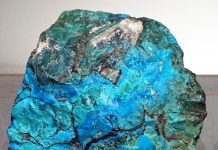
By Jim Brace-Thompson
Ichnology is the scientific study of so-called trace fossils. Rather than direct remains of an organism (bones, teeth, carbonized leaves, etc.), trace fossils provide a record in rock of an organism’s activity. These traces are also called ichnofossils. Such traces include fossilized dung, feeding marks on the edge of a leaf, burrows in the mud of an ancient seafloor, and fossil tracks. The most famous of all traces are tracks and trackways left by dinosaurs.
Dinosaur tracks from the Early Jurassic Period 200 million years ago have long been found in the Connecticut River Valley, where they were first interpreted to be the footprints of “Noah’s raven.” In 1966, a new state building was being constructed in Rocky Hill, Connecticut, when a bulldozer operator stumbled across what would prove to be 2,000 dinosaur tracks. Construction was halted immediately, and the area was preserved. One section is on public display within a geodesic dome, and an 80-acre area has been preserved as Dinosaur State Park. It’s considered the largest on-site display of dino tracks in the world.
Now, a comparable dinosaur track site is imperiled. In fact, a whole section already has been lost.
Per a recent report in the journal Geoscience Frontiers, dinosaur footprints and whole trackways began to appear 27 years ago during copper mining in Sichuan province of China. Gradually, more and more tracks came to light. In fact, researchers logged nearly 2,000 in all (the same number as in Connecticut) from all sorts of dinosaurs that lived during the Early Cretaceous Period 145-120 million years ago. The cast of characters that left their marks in stone included a whole ecological community of thundering, lumbering sauropods, ferocious meat-eating theropods, fleet-footed ornithopods, and even flying pterosaurs that took a break from the skies to amble across the land.
Regrettably, rather than being saved and preserved as with Dinosaur State Park in Connecticut, mining continued unabated at the Chinese site. Nearly a decade ago, before scientists could even finish mapping and measuring, one whole section of rock face collapsed, taking with it any scientific info that might be teased out. And still mining continues. Apparently, to the Chinese government, mineral riches outweigh scientific riches at this invaluable site. Here’s hoping scientists can outrace the bulldozers!
Author: Jim Brace-Thompson
 Jim began and oversees the AFMS Badge Program for kids, has been inducted into the National Rockhound & Lapidary Hall of Fame within their Education Category, and is the president-elect for the American Federation of Mineralogical Societies.
Jim began and oversees the AFMS Badge Program for kids, has been inducted into the National Rockhound & Lapidary Hall of Fame within their Education Category, and is the president-elect for the American Federation of Mineralogical Societies.
Contact him at jbraceth@roadrunner.com.
If you enjoyed what you’ve read here we invite you to consider signing up for the FREE Rock & Gem weekly newsletter. Learn more>>>
In addition, we invite you to consider subscribing to Rock & Gem magazine. The cost for a one-year U.S. subscription (12 issues) is $29.95. Learn more >>>
















